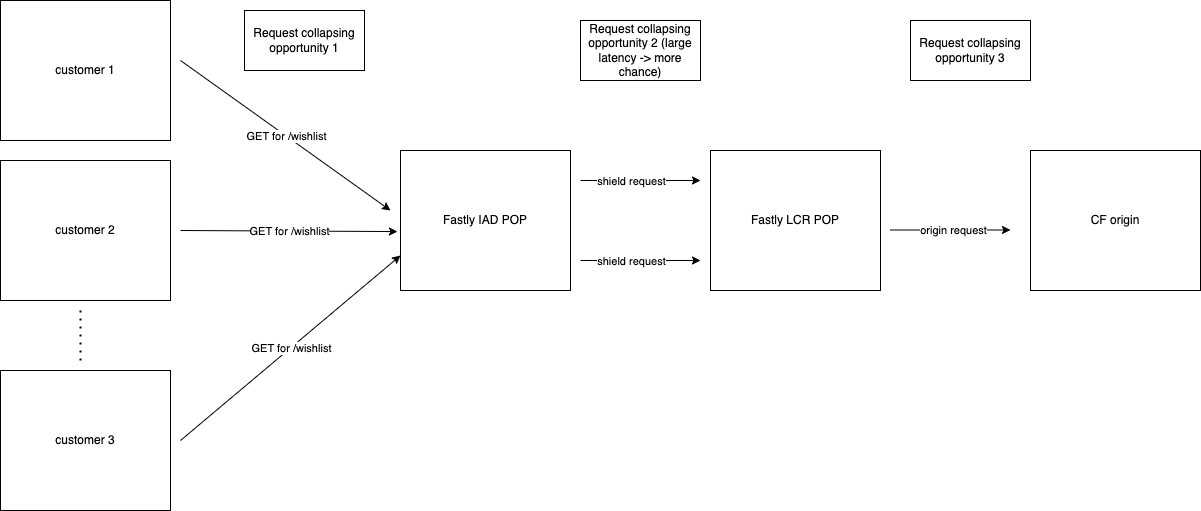Caching
Default Cache Behaviour
The default behaviour for Altitude is that requests are not cached by default. We want to be as flexible as possible and creating the assumption that responses can be cachable can lead to dangerous behaviour, especially when sensitive data is being returned.
SSR Caching
Cache-Control Header
You can override our default behaviour by adding Cache-Control headers in the responses of your functions.
There are three types of cache controls headers you can add to specify how caching behaves for your functions.
All times for Cache-Control headers are to be given in seconds. For more information regarding this header, please see the MDN Cache-Control Web Docs.
1. Max Age
Adding max-age to the Cache-Control header will indicate a time for the customers browser to store the response.
2. Shared Cache Max Age
Adding s-maxage to the Cache-Control header will indicate a time for our shared cache on the edge to store the response.
Note: This should not be returned on personalised pages as other users have access to this cache.
3. Stale While Revalidate
Adding stale-while-revalidate to the Cache-Control header will indicate a time for the users browser to serve stale data
if the other caches are expired. If stale data is served it will then refresh the cache in the backgroud, so the next request
has fresh data.
Example
If the following headers were added to the response of an SSR function:
Cache-Control: max-age=120; s-maxage=300; stale-while-revalidate=900
This will cache requests in the users browser for 2 minutes, we will cache them in the edge for 5 minutes and for 15 minutes after the cache expires, we will serve stale data whilst in the background we will refresh the cache.
Cache Configuration
Within Altitude, we give you the ability to fully customise you’re caching experience. You can specify custom caching length and cache keys on specific paths on your site.
A cache key serves as a unique identifier for each requested resource, and can contain information such as HTTP headers and cookies. It enables efficient storage and retrieval of cached content, optimizing delivery speed. By default the cache key only contains the host, path, query strings and the Accept-Encoding header however, on Altitude we maintain the ability to add additional information to it.
For example, if you’re site contains localised content based upon a locale cookie, we can pass this cookie into the cache key so that each locale maintains different cached responses and there can be no bleed.
An example of an Altitude.yaml file with caching enabled is below. For more information on the configuration, see the edge configuration.
version: v2.1provider: cloudflareroutes: # Add routes herecache: - pathRules: anyMatch: - /foo** ttlSeconds: 100 - pathRules: anyMatch: - /foo** noneMatch: - /foo/bar** key: headers: - X-FooThe result of adding this cache would be:
- For any path with a prefix
/foo, you would have a cache-control header ofmax-age=100. - For any path with a prefix
/fooexcluding paths with a prefix/foo/bar, you would be able to differ your cache by changing theX-Foorequest header. - For any other paths, the default settings remain.
Cache Purging
Cache purging can now be performed using the API endpoint POST sites/:siteId/domain/purge-cache with the body parameters domainName, purgeType, key, and allPathWildcards.
Below is a detailed explanation of all the body parameters expected by the endpoint:
domainName
The domain you want to purge, for example, www.foobar.com.
purgeType
This is an enum that accepts one of the following values:
path: Allows you to purge a specific path.surrogate-key: Allows you to purge a specific surrogate key returned by your site.all: Purges all paths on the domain.
key
This field depends on the value selected for field purgeType.
For purgeType:
path: The key should be the path you want to purge.surrogate-key: The key should be the surrogate key.all: The key field is not needed since it purges all paths.
allPathWildcards
When path is selected as the purgeType, setting this to true will purge all paths with the key as the prefix of the path.
CURL request
An example of how the curl would look like for cache purging:
Please follow the guide How to use Altitude API to get your bearer token.
curl -i --location 'https://api.platform.thgaltitude.com/v1/sites/:siteId/domain/purge-cache' --header 'Accept: application/json' --header 'Content-Type: application/json' --header "Authorization: Bearer $token" --data '{"domainName": "www.foo.com", "purgeType": "path", "key": "/bar", "allPathWildcards": true}'Request Collapsing
You should exercise caution if you are serving personalised pages to make sure that request collapsing doesn’t cause personalised responses to be served to the wrong customers. Note that this is different from caching, and can apply even if Cache-Control is set to no-cache, no-store.
Request collapsing is a performance optimisation to reduce origin load when multiple customers are asking for the same resource at the same time. Fastly groups together multiple incoming requests into a single origin request, then serves that one response to multiple customers. The diagram below shows the three opportunities in the request flow for this to happen.

Request collapsing will only happen on GETs where all the incoming requests share the same cache key.
To disable this behaviour for a particular path, you should:
- add a VCL snippet in your altitude yaml to disable caching (which also disables request collapsing)
content: |if (req.url.path == "/personalised/") {return(pass);}type: recvpriority: 100
- ensure that you add the
privatedirective to theCache-Controlheader on the response.
To read more about this, see here.